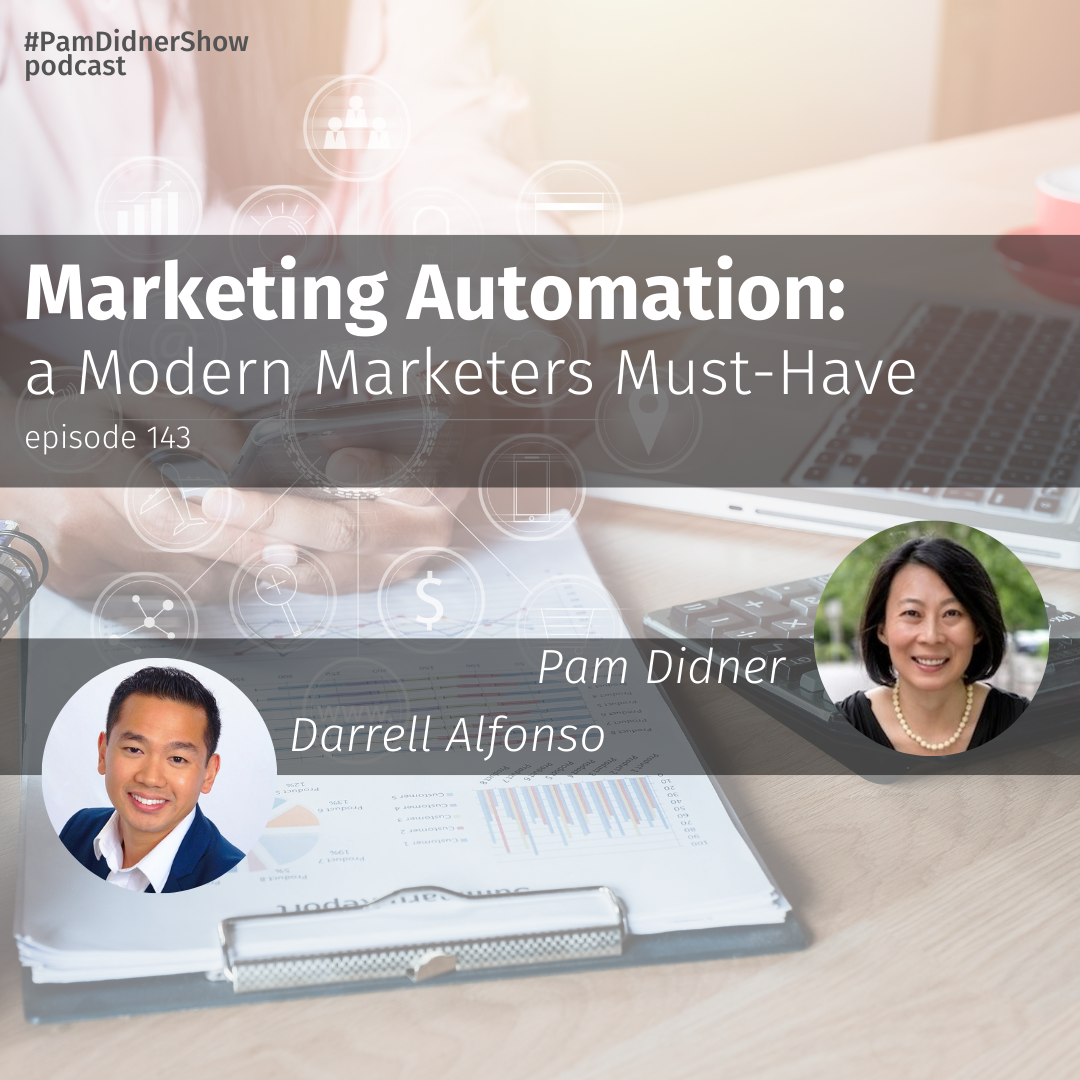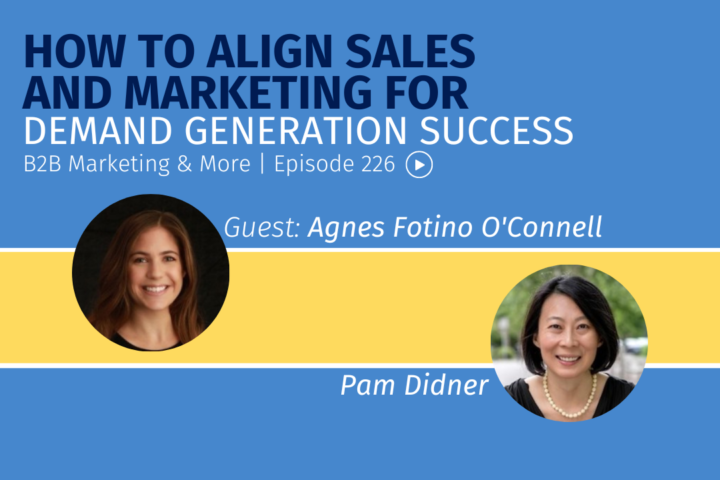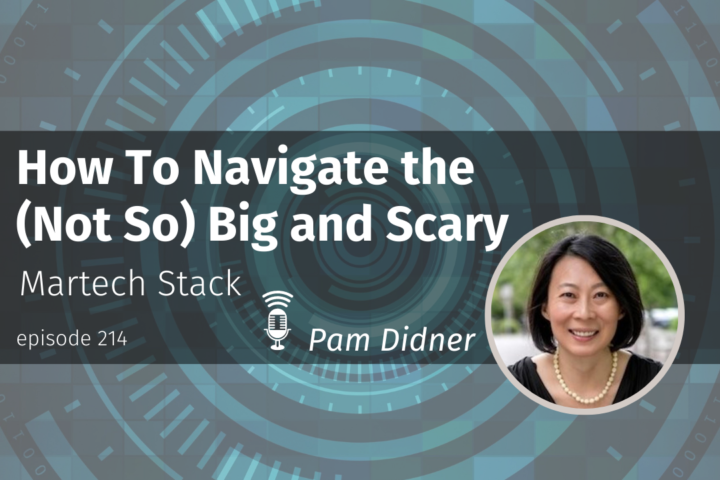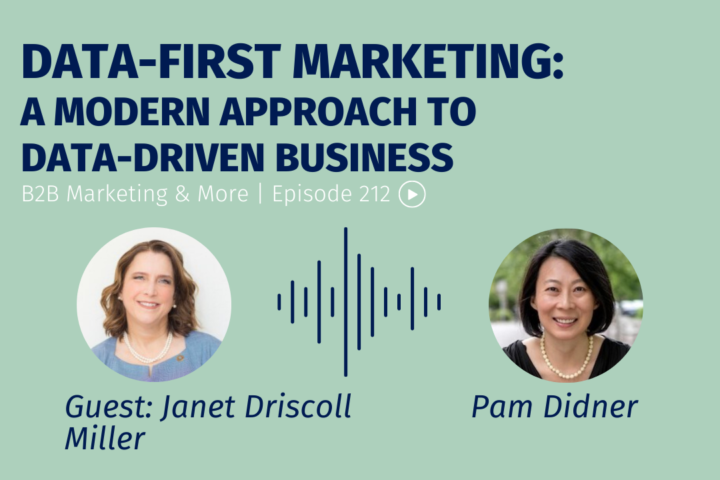
Welcome to another episode of B2B Marketing & More. I am interviewing a special guest from Amazon: Darrell Alfonso. Let’s get started!
Darrel has been in B2B marketing for almost ten years. He is the Global Marketing Operations Manager at Amazon Web Services, empowering hundreds of marketers to create exceptional digital experiences for Amazon customers. Darrel is a Marketo Champion and advisor to multiple different Fortune 500 companies.
In this episode:
- What is a marketing automation
- How to start with marketing automation
- How can businesses use automation to assist customer journey and improve touchpoints
- What are the top challenges in either implementing marketing automation or maintaining it
- The importance of understanding technology that businesses need to use
- What should marketing automation managers do to quantify their impact on revenue
- How can marketing automation help with obtaining high quality leads for sales
- How to stay on top of new tech and business skills
Quotes from the episode:
“Customers are different depending on your industry, product and service. The way that you implement marketing automation must be very custom and tailored to your organization.”
“One thing that I saw early on and why I chose marketing automation was because of how in-demand it was and how critical it was to most of the things that marketing does.”
—————
Enjoy the podcast? Subscribe to the show on your favorite podcast platform or leave a 5-star review and subscribe to Apple Podcasts.
If you prefer watching a video, I also have a YouTube Channel, check it out and subscribe.
If you want to chat, reach out to any social media channels or email me hello@pamdidner.com. You can also join my Facebook community: Build Your Marketing Skills to Get Ahead.
To keep on expanding your knowledge about marketing automation and technology check out some of my previous podcast episodes.
Strong Digital Marketing is About Processes and Automation
Three Use Cases of AI for Marketing
The Impact of Artificial Intelligence on Content Marketing
TRANSCRIPT
Hey, a big hello from Portland, Oregon. Welcome to another episode of B2B Marketing & More. I am interviewing a special guest from Amazon. Let’s get started!
So Darrell, welcome. So happy to have you on the show. And I know that you have a very, very strong marketing technology background. It sounds like we are certified for Salesforce. And you know multiple different–Marketo, like for example–marketing automation tool, very well. And you are Marketo champions, and you advise multiple different Fortune 500 companies. That’s very impressive.
Many marketers do not necessarily have the technical capability that you have. So welcome to the show. Do you want to spend a couple of minutes and give us any additional information about you?
Darrell Alfonso: Yeah, sure. And I’m so happy to be here. I’m an avid listener of your show, and I’m a reader of your content, so honoured to be here. So yeah, I’ve been in B2B marketing for about ten years. Six years ago, I was introduced to Marketo and marketing automation, a turning point in my career. I found that people were having such a hard time with these complex marketing automation platforms.
Pam Didner: I can concur. I do have a problem with that, and I cannot do a lot of stuff on my own. So, I have to work with a business consultant.
Darrell Alfonso: Yeah. Yeah. And it’s quite the same for a lot of marketers out there. So, in addition to driving results at work, I also became a contributor to the community. So I wrote articles I created how-to videos. I even ran the user group in Los Angeles when I was in Los Angeles.
After that, I won a few industry awards for my work in that community. And so today, my team runs one of the largest marketing automation platforms in the world. And I work for Amazon Web Services.
Pam Didner: Yeah, no kidding.
Darrell Alfonso: Our goal is to empower the hundreds of marketers that work for AWS to give them the tools and processes they need to create exceptional experiences for our customers.
Pam Didner: Got it. That makes a lot of sense. So speaking of marketing automation, Marketo Eloqua HubSpot, people tend to equate marketing automation with email marketing. So what is your definition of marketing automation? I’m curious. And then, what does that encompass?
Darrell Alfonso: I define marketing automation as the programmatic management of the customer lifecycle. And that encompasses automating and managing marketing activities throughout the awareness stage, the buying stage, and then even after they already become a customer.
Pam Didner: Got it.
Darrell Alfonso: Now, traditionally, this isn’t the industry-wide accepted definition of marketing automation. In a traditional sense, marketing automation for most companies includes lead management, lead scoring, nurturing, working with sales, and other advanced features like web personalization and marketing reporting. Those are the components that you typically make up marketing automation. But it is a lot more than email marketing,
Pam Didner: … email marketing. I 100% agree with that. The way I look at marketing automation, you are right. You have to encompass and consider the customer journey and that you are using the customer life cycle. But I think it’s to understand the different touchpoints that you are creating to reach out to your customer and try to make it trackable, and make an effort to analyze it to understand your customer a whole lot more.
So with that being said, what are the top two challenges, from what you can see, either implementing marketing automation or maintaining it?
Darrell Alfonso: That’s a good question. One of them is more strategic or high level, and that’s the trap of being too feature-driven. So, what I mean by that is it’s common to buy a marketing automation platform and then figure out, based on the features available, your marketing strategy and how you’re going to do your marketing. So you’re basing it on what technology is available to you, which determines what you’re going to do. And that’s very backwards.
The better way to do it is to figure out your goals and objectives first and then determine the specific features and technologies that will help you get there. That’s one of the big problems that I see in organizations today,
Pam Didner: So, when looking into the technology, it’s important to understand why you want to accomplish that, identify it, and then source the technology that will work with it.
Darrell Alfonso: Absolutely. And I think it’s easy to fall into that trap, especially for marketers that have never done it before. So they’re very tempted to say, “okay, what can the tool do? So that’s what we’re going to do.” But the same set of features is not right for every company. Customers are different depending on your industry and depending on your product and service. The way that you implement marketing automation must be very custom and tailored to your organization.
Pam Didner: You know, speaking of that, you say it has to be custom and tailored for your organization. So what is your take on make versus buy?
Darrell Alfonso: Yeah. If you’re just starting, I think the only way to get some of the marketing technology you need is to buy it. So if you are in the situation of build versus buy, the way I think about it is to look down the road five or ten years. To see what that will look like and what the service or activities you’re going to do will look like for both the vendor and then for you. And then you have to calculate all the costs.
Pam Didner: What do you mean? Do we need to spend money? (laughs)
Darrell Alfonso: Exactly. It’s such an important thing to think about because if your business doubles or triples in size, you may need a lot more than what your platform provides today. And if you get to that stage, when you’re five years into the future, the marketing technology roadmap will be heavily driven by the vendor and not you, right? There’s only a handful of customers that can drive a vendor’s roadmap.
Pam Didner: Right.
Darrell Alfonso: And it may not fall in your favor. So that’s how I kind of think about it. It’s tough to do all those calculations, but I think if you list out the key things you need and look ahead and anticipate the amount of service you’re going to need in the future, that can help you make a good decision.
Pam Didner: Yeah, I hear you. I mean, it’s nice, especially on the enterprise side. You can think ahead in terms of what your Martech stack roadmap will look like. And, just like you said, it just needs to be driven from the objectives and your business directions that you want to go.
Darrell Alfonso: Right.
Pam Didner: But for small businesses, obviously a lot of time, even though they want to look ahead, they probably can’t. They can see probably like a product roadmap of growth for the next five years. But in terms of how marketing will morph a lot of time, the mid-size companies or even small businesses probably don’t have that ability or can even afford to look that much ahead.
And, um, I’m using myself as an example, Darrell, here. When I started just using data management as an example, I used Dropbox when I started. And I have everything in Dropbox, and I have had that for four years. And then last year during Christmastime, I said, guess what? “I want to structure my Dropbox. And I want to put that in G Suite.” So I put everything kind of like in G Suite.
So I made that massive transition, literally killed my January, sorry, my Christmas holiday, because I was doing that. That was kind of like a little bit dumb ass on my part if you will. I’m trying to do that during the holiday, and then I discovered Zoho. Zoho is kind of like an office platform that they have as CRM. They have Zoho Forms, they have Zoho Campaigns, which is an email marketing automation tool.
Suddenly, I don’t have to use Drip for my marketing automation and use Salesforce as my separate tool. Those tools are wonderful, but if I want those tools to talk to each other, I have to hire someone else to write a code to ensure they talk to each other, in addition to connecting just API, right?
So then, in June, I make a massive transition from G Suite to Zoho. So I transfer over 14,000 files from Google Drive to actually to their Zoho work drive. That was a huge amount of work. But again, as a small business, I probably can’t afford to have that kind of roadmap, but having everything under one umbrella. Oh my God. Darrell. I have to tell you. Talk about efficiency!
Darrell Alfonso: Yeah. I completely agree.
Pam Didner: It makes a huge difference. But it’s a lot of work. Martech, in general, is just a lot of work. So I drink a lot. (laughs) Okay. I drink a lot. I drink a lot of tea! Come on.
Darrell Alfonso: (laughs) There you go. There you go. Yeah. I mean, I agree with you. I think that that’s one of the major problems today is the disparate systems that you have to work with. And having data in different areas.
While I was running, I had this great vision of what the future would look like. I don’t think it will be one platform to rule them all, but I think it will be standardized. So you know how the Microsoft Office Suite of products, how you can just take a spreadsheet and then paste it into PowerPoint or paste it into Outlook and everything is always the same. And you can understand it and comprehend it. And it becomes more of like, just tools that you’re familiar with using so you can get your work done. That’s how I think the future is going to be when it comes to marketing technology.
Like it’s not going to be all in one place, but everything will be more standardized so that you can do stuff versus what you said, like spending your entire Christmas holiday moving things around. (laughs) Yeah. So….
Pam Didner: Yeah, a lot of the time, of course, you can hire people to do that. But the reason I did that, I kind of want to be in the trenches; that’s because I want to learn. I think Darrell, I am jealous that you are the Marketo champions and certified Salesforce admin. I think that kind of skill set is important. I’m not saying that you must have. That’s not my point. But it’s super critical to be a future or next-generation marketer.
Darrell Alfonso: Yeah, I think so. I saw early on why I chose marketing automation because of how in-demand it was and how critical it was to most of the things that marketing does.
Pam Didner: They touch everything because digital because it’s digital, you need to build a system in the back end to talk to each other. Yes.
Darrell Alfonso: Yeah. And, and that’s, that’s how I advise people, especially when they’re coming out of college, is to develop those niche or in-demand skills because you can then work anywhere. People always need technical marketers that know how to get the job done. I’ve truly benefited from that in my career.
Though I do, I’m still hoping that the platforms will become easier and become just a tool versus something that you have to study hours and hours for. But, I completely agree with you. The technical skills are today, especially, is really in demand.
Pam Didner: Yeah. There is another question I want to ask your opinion. When I talk to many marketers and focus on the front end, they focus on email marketing outreach. They focused on email marketing because that’s very much tied with lead gen if you do email marketing. You create leads for the sales team, and you do email marketing, the same thing. You capture the prospects, and then you nurture them. Which is all good, right?
It’s much easier to quantify the marketing’s contribution to, say, the sales and the business growth. And for marketing automation, a lot of them are really about the backend and processes. And it’s really about setting things up. So as a marketing automation manager, how do you quantify your impact on revenue from your perspective?
Darrell Alfonso: Right. So the first thing, though, that I want to say is that though that job is typically backend, I think that good marketing automation managers will find more and more ways to contribute to a better customer experience. Because the platform itself has many more front-facing areas, like landing pages and emails and advertising is often managed in these systems. Right?
If you can take the data behind that and advise on making more strategic marketing decisions, I think that that can get you out of the back office all the time. That’s one thing that I want to preface, what I want to say, say first.
Pam Didner: Okay.
Darrell Alfonso: The next thing that I recommend if you’re having trouble proving your impact is to get involved with the critical business reports of the marketing teams…
Pam Didner: Dashboards, building the dashboards.
Darrell Alfonso: Right. So, marketing automation people are well-positioned for that because much of the data is already there. You’re looking at activity, data engagement, data that’s in the marketing automation platform, or the CRM. So often, you are building the connection between the tools and then some sort of dashboard.
And if you’re the owner of reports, you’re often looked at as the strategic advisor. Because leadership will say, “Well, Darrell, you know, I know that you didn’t create this campaign, but why…”
Pam Didner: “Why is the number down?”
Darrell Alfonso: Why is the number down? Right. So then, I have become more of a strategic advisor versus someone that’s just handling the technical stuff. So, I think that that will be a really big, important part if you want to try to show your impact.
Pam Didner: I love your answer, not just focused on the process but also getting involved in data analytics. Because you know, the data and the tools inside and out might as well just take it one step further. And another thing that you suggested–which is, I love it, I love it so much–is like, yeah, I’d be the dashboard owner. Again, you know, the tools, you know, the processes. Why don’t you just build a dashboard for everybody?
I love these two! Excellent, excellent ideas. Before, I was like, “I’m just doing the process. You are on the backend, you know like you are invisible. How do you make yourself visible?”
Darrell Alfonso: Yeah.
Pam Didner: You know, so the last question I wanted to ask you is to touch a little bit on this, and it’s, what’s ahead for the marketing automation, from your perspective. And you touch a little bit in terms of standardization, and pretty much all the big players need to have a come-to-Jesus meeting. Right? (Darrell laughs) Some things like standardized to make the end-user’s job a whole lot easier. I agree with that. And hopefully, they will do that.
What else? What else from your perspective that, using your crystal ball, that you can see ahead?
Darrell Alfonso: I mean, it’s sort of aligned, but one of the big problems today is within your marketing automation platform. You usually have email marketing and maybe web personalization. But today, especially as the buyer journey changes, you need a lot more. So you need content discovery. You need advanced lead routing, which is a little bit in the weeds there…
Pam Didner: No, it’s not! That’s the most important part– high quality leads for your salespeople.
Darrell Alfonso: Yeah. So you, you need that. And then, you need customizable reporting that works well for your organization. To get that, you need to build a stack of marketing technology literally and then weave it in, stitch it together. So, yeah, that’s very limiting from a cost standpoint, from a resources standpoint. You have to learn all these different tools.
So, I see the core marketing automation platforms either buying or building those new technologies or services that work with the way people buy today, you know? And then that’s through things like content and social media. That’s a big thing that I can see is probably going to happen.
Pam Didner: Very, very good. So to wrap it up, why don’t you tell our listeners how they can find you?
Darrell Alfonso: Yeah. So LinkedIn is my favorite Twitter, probably my second favorite and yeah. They can reach out to me. I post a lot of my thoughts on how to do marketing automation and operations. So I do think that if they have questions on how I think about it and how I strategize it, you pretty much just have to look at my content. I don’t mind people reaching out to me. I might be a little slow to respond,
Pam Didner: You work full-time, so understandable. It’s all good. So very good. Excellent. So I have one silly question I want to ask you.
Darrell Alfonso: Yes
Pam Didner: So what is the most useless talent you have?
Darrell Alfonso: Useless talent.
Pam Didner: Yeah. Useless (laughs)
Darrell Alfonso: Okay. So, I haven’t told many people this, but I can do tarot card readings. (laughs)
Pam Didner: Really?
Darrell Alfonso: Yeah. So I have a deck, and then maybe one day I’ll have to go practice a little bit, but you know, I’d be happy to read your fortune (both laugh). And I’ll tell you exactly what’s going to happen to you (laugh).
Pam Didner: That’s useless? I think that’s very useful.
Darrell Alfonso: Yeah, well, I think my friends and family think it might be useless, but you know, it’s fun. (laughs)
Pam Didner: I love it. Did you learn that somewhere?
Darrell Alfonso: I did. Yeah. I have a book on how to do it. And then, I watched a lot of videos. You know, there’s a lot of depth when it comes to it, and also, it’s a little bit personal with who you do the reading for, right? Because if I read your fortune versus my brother’s, you know, and a card like a tower comes up or something like that, I would read it differently because it depends on the person.
Pam Didner: It depends on who. I 100% agree with you. So a friend of mine now we got just dragging it a little bit. Just bear with us. And I have a very good friend, and her name’s Donna. And, she firmly believed she was a witch, like in her previous life. Right? And she can, she does, uh, the toro–, it’s called tarot cards, right? I have to say there were a couple of times when she read my fortune, like, oh, this is whatever she didn’t necessarily need to be very specific, but like certain things is going to happen right, at a certain time. And she would call that out and, well, it happened!
Darrell Alfonso: Yeah.
Pam Didner: I think that’s very useful.
Darrell Alfonso: Yeah. So anyway, I won’t make your listeners listen to more of this tarot episode (laughs)
Pam Didner: (laughs) If you are interested in having your fortune read, you can also reach out to Darrell through LinkedIn. Thank you so much for coming to my show. I appreciate it, Darrell, and your insight about marketing automation is spot on, and we appreciate that you can join us.
Darrell Alfonso: Thanks a lot for having me, Pam
Pam Didner: Again, thank you so much for listening to my podcast. And podcasting is one-way communication, and I don’t necessarily know who you are, but your support means a great deal to me.
If you want to chat, reach out on any social media channel, and join my Facebook community. Build Your Marketing Skills to Get Ahead. When you join, you get a free Starbucks on me. You can go to the Announcement tab and click on the barcode of the gift card.
Love to hear from you. Take care. Bye-bye!



